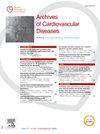Cardiovascular impacts of exacerbated emphysema in an elastase-LPS rat model: Effects of emphysema extent and aging
IF 2.3
3区 医学
Q2 CARDIAC & CARDIOVASCULAR SYSTEMS
引用次数: 0
Abstract
Introduction
Chronic Obstructive Pulmonary Disease (COPD), the third leading cause of death worldwide, has two main components: distal airways obstruction and emphysema (destruction of lung parenchyma). This chronic condition is complicated by disease exacerbations, mainly due to infections. COPD patients often present numerous comorbidities, particularly cardiac, which are linked to poor clinical prognosis. Our team previously developed an animal model of exacerbated emphysema: “ELA-LPS” rats, which exhibit heart failure with preserved ejection fraction (HFpEF) 5 weeks after exacerbation, as seen in clinics.
Objective
We aimed to determine whether the cardiovascular effects observed in ELA-LPS rats are correlated with the extent of pulmonary emphysema and investigate the influence of aging.
Method
Emphysema was induced in male Wistar rats by weekly elastase (ELA) instillations for 4 weeks. The final instillation included bacterial lipopolysaccharide (LPS) to induce exacerbation. In vivo experiments and euthanasia were performed 5 weeks after. Firstly, we tested different doses of elastase (4U, 6U, 10U) in 6-week-old rats to assess whether cardiovascular consequences depend on emphysema severity. Secondly, a dose of 10U elastase was used in 18-month-old rats to study aging effects. Pulmonary emphysema was evaluated by histology and lung compliance was measured ex vivo, while in vivo plethysmography assessed respiratory function. Cardiovascular properties were evaluated in vivo by tail-cuff blood pressure measurement, echocardiography, and maximal cardiorespiratory exercise test (VO2max).
Results
In 6-week-old rats, lung histology confirmed elastase dose-dependent emphysema. This led to increased compliance and respiratory dysfunction. ELA-LPS rats exhibited dose-dependent arterial hypertension and HFpEF (preserved LVEF, increased E/E′ ratio), with diastolic dysfunction correlated to emphysema severity (R2 = 0.53, P = 0.0003). These abnormalities resulted in reduced exercise tolerance during VO2max tests. Furthermore, aging worsened impairments, as older rats showed more severe dysfunctions. Notably, old ELA-LPS rats developed heart failure with reduced ejection fraction (HFrEF).
Conclusion
Our procedure induced a dose-dependent emphysema with vascular, cardiac (dose-dependent diastolic dysfunction), and general consequences in adult rats. Aging significantly affected the phenotype, with older rats developing HFrEF.
弹性酶lps大鼠模型中加重肺气肿对心血管的影响:肺气肿程度和衰老的影响
慢性阻塞性肺疾病(COPD)是全球第三大死亡原因,有两个主要组成部分:远端气道阻塞和肺气肿(肺实质破坏)。这种慢性疾病因疾病恶化而复杂化,主要是由于感染。慢性阻塞性肺病患者经常出现许多合并症,特别是心脏合并症,这与临床预后不良有关。我们的团队先前开发了一种加重肺气肿的动物模型:“ELA-LPS”大鼠,在加重5周后表现出心力衰竭并保留射血分数(HFpEF),与临床观察一致。目的探讨ELA-LPS大鼠的心血管效应是否与肺气肿程度相关,并探讨衰老对肺气肿的影响。方法采用弹性蛋白酶(ELA)诱导雄性Wistar大鼠肺气肿4周。最后滴注细菌脂多糖(LPS)诱导恶化。5周后进行体内实验和安乐死。首先,我们在6周龄大鼠中测试了不同剂量的弹性蛋白酶(4U, 6U, 10U),以评估心血管后果是否与肺气肿严重程度有关。其次,在18月龄大鼠中使用10U弹性蛋白酶来研究其衰老作用。通过组织学评估肺气肿,体外测量肺顺应性,而体内体积脉搏图评估呼吸功能。通过尾袖血压测量、超声心动图和最大心肺运动试验(VO2max)在体内评估心血管特性。结果6周龄大鼠肺组织学证实弹性蛋白酶剂量依赖性肺气肿。这导致依从性增加和呼吸功能障碍。ELA-LPS大鼠表现为剂量依赖性动脉高血压和HFpEF (LVEF保存,E/E′比值升高),舒张功能障碍与肺气肿严重程度相关(R2 = 0.53, P = 0.0003)。这些异常导致最大摄氧量测试时运动耐受性降低。此外,衰老恶化了损伤,因为年老的大鼠表现出更严重的功能障碍。值得注意的是,老年ELA-LPS大鼠发生心力衰竭,射血分数(HFrEF)降低。结论:我们的手术在成年大鼠中诱导了血管、心脏(剂量依赖性舒张功能障碍)和一般后果的剂量依赖性肺气肿。衰老显著影响表型,老年大鼠出现HFrEF。
本文章由计算机程序翻译,如有差异,请以英文原文为准。
求助全文
约1分钟内获得全文
求助全文
来源期刊

Archives of Cardiovascular Diseases
医学-心血管系统
CiteScore
4.40
自引率
6.70%
发文量
87
审稿时长
34 days
期刊介绍:
The Journal publishes original peer-reviewed clinical and research articles, epidemiological studies, new methodological clinical approaches, review articles and editorials. Topics covered include coronary artery and valve diseases, interventional and pediatric cardiology, cardiovascular surgery, cardiomyopathy and heart failure, arrhythmias and stimulation, cardiovascular imaging, vascular medicine and hypertension, epidemiology and risk factors, and large multicenter studies. Archives of Cardiovascular Diseases also publishes abstracts of papers presented at the annual sessions of the Journées Européennes de la Société Française de Cardiologie and the guidelines edited by the French Society of Cardiology.
 求助内容:
求助内容: 应助结果提醒方式:
应助结果提醒方式:


